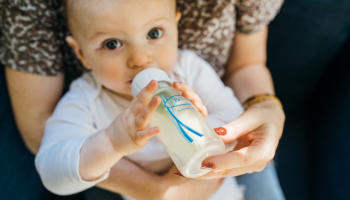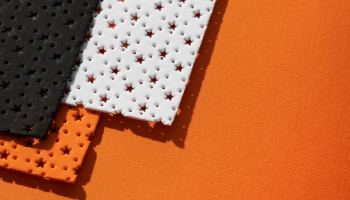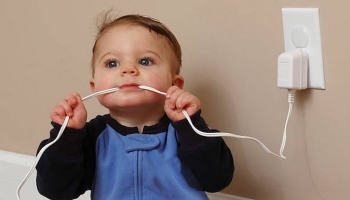
Teaching a baby to drink from a straw can be a challenging task for many parents. However, it is an essential skill that can help them transition from bottle or breast milk to a cup. Sipping from a straw also promotes the development of oral muscles and coordination, which are crucial for speech and eating.
Before introducing the straw, it is important to ensure that the baby is developmentally ready. Typically, babies can start using a straw around six months of age when they can sit up and hold their head steady. It is also important to choose the right type of straw that is safe and appropriate for their age and needs. Parents can opt for a soft silicone straw or a hard plastic one with a valve to control the flow of liquid.
To teach the baby to use a straw, parents can start by demonstrating how to suck on the straw themselves. They can then place the straw in the baby’s mouth and gently guide them to suck. It may take several attempts before the baby gets the hang of it, so patience and persistence are key. With time and practice, the baby will learn to drink from a straw like a pro.
Understanding the Basics
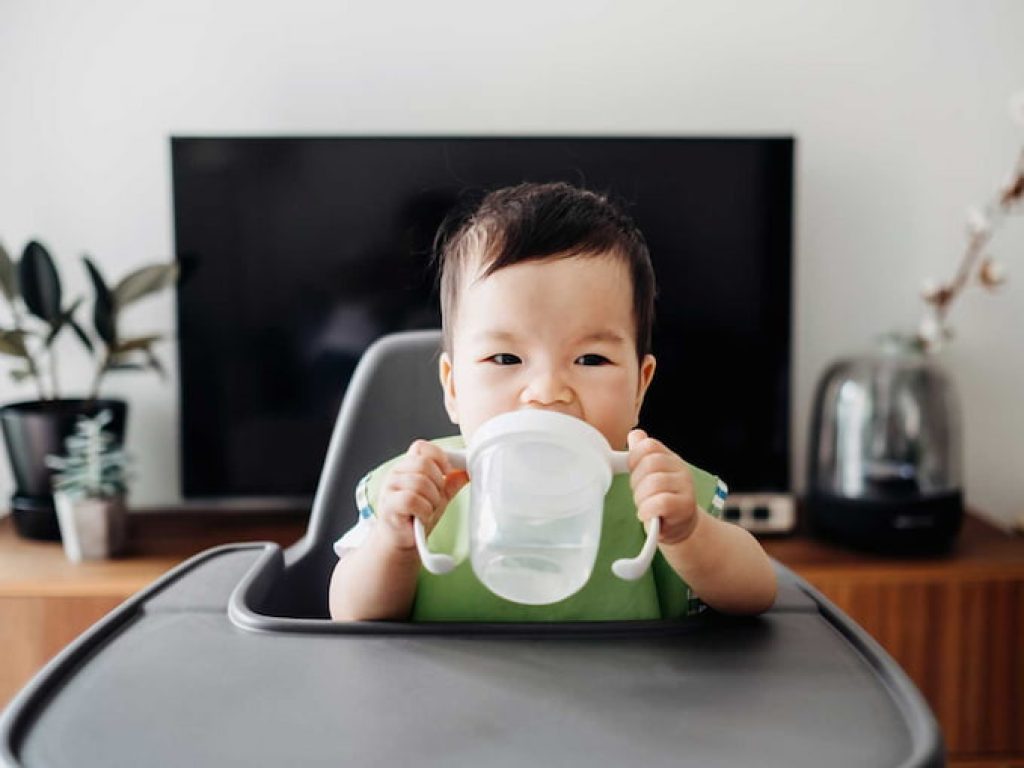
What is a Straw Cup?
A straw cup is a sippy cup that has a straw instead of a spout. The straw or mini cup is usually made of silicone or plastic and is designed to be gentle on a baby’s gums and teeth. Sippy cups come in a variety of shapes and sizes, and some even have handles to make it easier for little hands to hold.
Why Teach Baby to Drink from a Straw?
Teaching a baby to drink from a straw has many benefits. For one, it can help with their oral development. Drinking from a straw requires different muscles than drinking from a bottle or sippy cup, which can help strengthen their mouth and jaw muscles. It can also help with speech development, as it encourages them to use their tongue and lips in different ways.
Another benefit of using a straw cup is that it can help prevent tooth decay. Sippy cups with spouts can cause liquids to pool in a child’s mouth, which can lead to cavities. Straw cups, on the other hand, encourage a child drink with a more natural drinking motion and reduce the amount of liquid that stays in the mouth.
When Can Babies Drink from a Straw?
Most babies can start drinking from a straw at around 6 months of age. However, it’s important to choose a straw cup that is appropriate for their developmental stage. Some straw cups are designed for younger babies and have shorter, skinny straws, while others are meant for older babies and have longer straws.
Open Cup vs. Straw Cup
While some parents opt for an open cup for their babies, a straw cup can be a good middle ground between a bottle and an open cup. Straw cups are less messy than open cups and can help prevent spills. They also allow babies to drink at their own pace, without the risk of choking or over-sipping.
Overall, teaching a baby to drink from a straw can be a great way to support their oral and speech development, while also helping prevent tooth decay. When choosing a straw sippy cup, it’s important to consider your baby’s age and developmental stage, as well as the features of teach straw drinking the cup itself.
Preparation for Transition
Teaching a baby to drink from a straw can be a challenging task, but with the right preparation, it can be made easier. Here are some things to consider when introducing straw drinking and preparing for the transition.
Choosing the Right Straw
When choosing a straw for your baby, it is important to consider the size and material. A straw that is too small may be difficult for your baby to use, while a straw that is too large may cause choking. A silicone or soft plastic straw is recommended as it is gentle on your baby’s gums and teeth.
Preparing the Liquid
Before introducing a straw to your baby, it is important to ensure that the liquid you are offering is appropriate. Water is a good place to start, as it is easy to drink and does not require much effort. Once your baby has become comfortable with water, you can gradually introduce other liquids such as milkshakes or thicker liquids like puree or solid foods.
To prepare the liquid for your baby’s lips, use a cup with a lid and a straw. Fill the cup with a small amount of liquid, no more than an ounce or two, and place the straw in the liquid. Gently squeeze the cup to draw the liquid up into the straw, and then place the straw in your baby’s mouth. Encourage your baby to suck on the straw by gently squeezing the cup to release more liquid.
By choosing the right straw and preparing the liquid appropriately, you can make the transition to straw drinking easier for your baby. With a few weeks of patience and persistence, your baby will soon be able to drink from a straw like a pro.
5 Steps to Teach Your Baby to Drink From a Straw
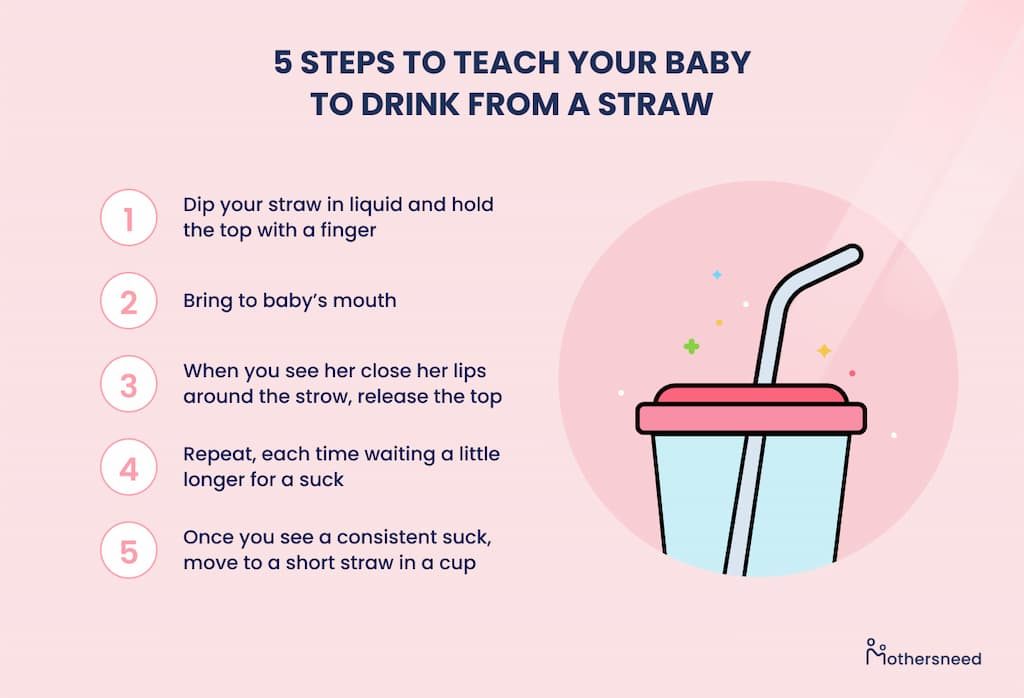
Teaching a baby to drink from a straw can be a challenging yet rewarding experience. It not only aids in their motor skills development but also prepares them for independent drinking. Below is a step-by-step guide to ease this learning curve.
Before we delve into the detailed steps, it’s crucial to underscore the following preliminary approaches to ease the baby into the process of learning how to drink from a straw:
Starting Slowly
It is important to start slowly when introducing a straw to a baby. Parents can start by letting the baby play with a straw and get familiar with it. Once the baby is comfortable holding the straw, parents can start by placing the straw in a cup of water and letting the baby see the water being drawn up the straw.
Using the Finger Over One End Technique
One effective technique to teach a baby to drink from a straw is the finger over one end technique. Parents can place their finger over one end of the straw, and then dip the other end into a cup of water. Once the straw is filled with water, parents can remove their finger and let the baby drink from the straw. This technique allows the baby to learn how to suck on the straw without having to worry about too much air coming through.
1. Dip your straw in liquid and hold the top with a finger
In this initial step, choose a liquid that your baby is familiar with to make the experience less intimidating. You might opt for water or juice for this practice. Dip the straw into the selected liquid, ensuring it is adequately immersed. Hold the top of the straw with your finger to trap the liquid inside. This not only allows for easy control but also ensures that the liquid is ready to be released once the baby engages with the straw.
2. Bring to baby’s mouth
With the liquid trapped in the straw, bring it gently to your baby’s mouth. Ensure that the atmosphere is calm and conducive for learning to avoid distracting the baby. Hold the straw steady, allowing the baby to explore and feel the straw with their lips and mouth. This step is essential for familiarizing the baby with the new drinking tool.
3. When you see her close her lips around the straw, release the top
Patience is crucial in this step. Watch your baby closely. As soon as her lips wrap around the straw, slowly release your finger from the top. The trapped liquid will then flow into the baby’s mouth. This unexpected yet controlled flow will initiate the baby’s natural sucking reflex. Be ready to offer words of encouragement and comfort to make this a positive experience.
4. Repeat, each time waiting a little longer for a suck
Consistency and repetition are your allies in this step. Repeat the process, each time allowing a moment of anticipation before releasing the liquid. This pause encourages the baby to initiate a suck, reinforcing the connection between the sucking action and getting a drink. Always be observant and responsive to the baby’s reactions, adjusting your pace to suit their comfort and readiness.
5. Once you see a consistent suck, move to a short straw in a cup
By this stage, your baby has started to grasp the concept of sucking from a straw. Celebrate this milestone and prepare for the transition to a more independent drinking phase. Introduce a short straw placed in a cup, allowing the baby to explore and adapt to this new setup. The short straw makes it easier for the baby to control the liquid flow and promotes self-feeding, marking a significant step towards independent drinking.
Open Cup vs Sippy Cup
Open cups and sippy cups serve different functions in a child’s developmental progression towards independent drinking. Here are some of the key differences between the two:
Design:
- Open Cup: As the name suggests, an open cup does not have a lid. It’s similar to a regular cup that adults use but is typically smaller in size for tiny hands.
- Sippy Cup: Designed with a lid that prevents spills. The child drinks by sipping from a spout or valve on the lid.
Purpose:
- Open Cup: Teaches babies the concept of sipping and swallowing without any interference. It helps in developing coordination to bring the cup to the mouth without spilling.
- Sippy Cup: Acts as a transitional tool from bottles or breastfeeding to regular cups. The design helps to reduce the mess, especially when the child is on the move.
Age Appropriateness:
- Open Cup: Can be introduced as early as 6 months, under supervision, for short practice sessions.
- Sippy Cup: Typically introduced around 6-12 months, after weaning off the bottle.
Mess Factor:
- Open Cup: High potential for spills, especially during the initial stages of learning.
- Sippy Cup: Designed to be spill-proof or at least spill-resistant, making it convenient for travel and less supervised situations.
Oral Development:
- Open Cup: Encourages proper tongue and mouth muscle development, as the child learns to sip and swallow.
- Sippy Cup: While it can aid in transitioning from the bottle, prolonged use can potentially hinder oral development. It can also affect dental health if the child sips on sugary liquids for extended periods.
Hygiene:
- Open Cup: Typically easier to clean since it doesn’t have multiple components.
- Sippy Cup: Can have several parts, like valves or seals, that may be harder to clean thoroughly, leading to potential mold or bacteria buildup if not cleaned properly.
Durability and Safety:
- Open Cup: Usually made of durable materials like plastic, stainless steel, or silicone. There’s less risk of parts breaking off, but the open nature can lead to more frequent spills.
- Sippy Cup: Often made from durable materials, but some have parts (like the spout or valve) that can wear out or break with prolonged use.
Patience and Practice
Teaching a baby to drink from a straw is a developmental journey that requires ample patience and consistent practice. Each baby’s pace of grasping this new skill varies, and it’s important for caregivers to remember that the process is as significant as the end result.
With every attempt, the baby is not only learning the mechanics of straw drinking but also honing their motor skills, coordination, and understanding of the world around them. It’s common to encounter initial resistance or confusion, with many babies blowing into the straw or using it as a teething tool. However, with patient guidance, positive reinforcement, and regular practice, most babies eventually make the connection.
Instead of showing frustration during the messy attempts or spills, celebrating small victories and setting a calm, encouraging atmosphere can make the experience enjoyable for both the baby and the caregiver. After all, patience in these formative moments lays the foundation for a child’s confidence and resilience in learning new skills throughout life.
Frequently Asked Questions
What is the best cup to use when teaching a baby to drink from a straw?
When teaching a baby to drink from a straw, it is best to use a straw cup that is specifically designed for babies. These cups typically have a soft, flexible straw that is easy for babies to use. Look for cups that are spill-proof, easy to hold, and made of safe materials.
How can I train my baby to use a sippy cup?
To train your baby to use a sippy cup, start by offering it during mealtimes. Encourage your baby to hold the cup and show them how to tip it up to drink. You may need to help your baby at first, but with practice, they will learn to use the cup on their own.
At what age can a baby start drinking from a straw?
Most babies can start drinking from a well weighted straw cup at around 6 to 9 months of age. However, every baby is different, and some may take longer to learn than others. It is important to be patient and keep offering the straw cup regularly.
What are some tips for teaching straw drinking during speech therapy?
When teaching straw drinking during speech therapy, it is important to start with short, frequent practice sessions. Use a safe straw drinking cup that is appropriate for your baby’s age and skill level, and offer plenty of positive reinforcement. You can also try incorporating fun games or activities to make the practice more engaging.
Is it better to teach a baby to drink from an open cup or a straw cup?
Both open cups and straw cups have their benefits, and it ultimately depends on your baby’s individual needs and preferences. Open cups can help promote proper oral motor development, while straw cups can be easier for babies to use and can help prevent spills. It is important to introduce both types of cups and let your baby experiment with them.
Are there any risks associated with using straw cups for babies?
While straw cups can be a great tool for teaching babies to drink, there are some risks to be aware of. If a baby is not supervised while using a straw cup, they may accidentally swallow too much liquid, which can lead to choking or aspiration. Additionally, using a straw cup too frequently or for too long can increase the risk of tooth decay.



